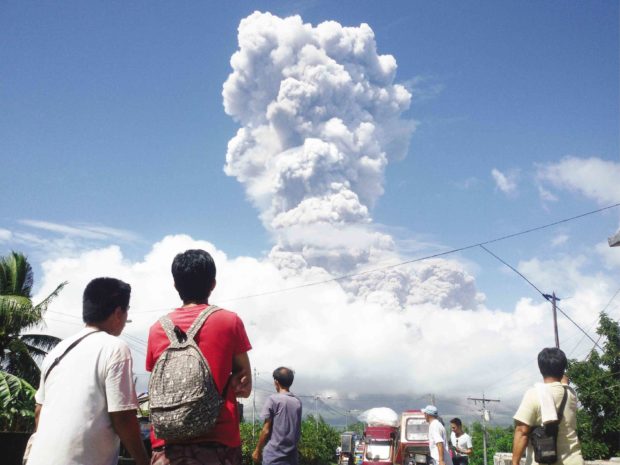
SMOKE SIGNAL Mayon volcano expels a column of ash on Jan. 22, leading Phivolcs to raise its alert level from 3 to 4.
LEGAZPI CITY — It may be a tourist attraction for its perfect cone, but Mount Mayon, being an active volcano, can be quite a handful for both locals and government officials here. But thanks to those who keep watch 24/7 over it, Albay folk are assured of early warnings and updates.
“Mayon is quite special because it is our most active volcano and like many stratovolcanos, its activity is quite difficult to predict,” said Ma. Antonia “Mariton” Bornas, chief of Volcano Monitoring and Eruption Prediction Division at the Philippine Institute of Volcanology and Seismology (Phivolcs).
This characteristic of Mayon and other stratovolcanos is challenging, interesting and frustrating all at the same time, she added.
“We have to be on our toes all the time and keep our vast monitoring networks at optimum efficiency all the time. Yet, it keeps frustrating us by behaving in a different way in terms of monitoring parameters,” Bornas said.
The volcano monitoring division of Phivolcs gives data to its principal stakeholders, including the Office of Civil Defense which disseminates information and coordinates with local government units.
CLOSE MONITORING Volcanologist consulting a map at Phivolcs observatory in Legazpi City
The division also gives information, within 10 minutes of a major and minor eruption, to the Civil Aviation Authority of the Philippines, the Office of the Press Secretary in Malacañang, the Department of Science and Technology, and other agencies.
“As Filipino volcanologists, we have an important service to provide,” Bornas said.
AT WORK Volcanologists at Phivolcs observatory in Legazpi City —PHOTOS BY GEORGE GIO BRONDIAL
Deadly beauty
Since Jan. 14, Mayon volcano has been under Alert Level 3 after Phivolcs observed lava spewing out of its crater and the presence of a new lava dome. After more than a week, the volcano was still exhibiting the same level of unrest and eruption, until early this week, when it shot lava some 700 meters into the sky. Phivolcs has raised its alert level to 4, with at least 61,000 people forcibly evacuated for safety.
“It is our way of life. The way we give service and ensure the safety of our community is also how we treat our own family,” said Abundio “Jukes” Nuñez, 48, special operations officer at Albay Public Safety and Emergency Management Office.
7 eruptions
In his 22 years in service, Nuñez has witnessed Mt. Mayon’s seven eruptions in 1993, 1999, 2000, 2001, 2006, 2009 and 2014.
Nuñez started working on disaster-related operations in 1991 through the Philippine Red Cross. In 1995, he was transferred to the Albay Provincial Disaster Risk Reduction and Management Council.
“My worst experience with Mayon was the 1993 eruption when 77 farmers died. That was our longest stay in evacuation centers. The Philippine Red Cross later adopted six evacuation centers. I was one of the volunteers who took care of the evacuees’ needs for three and a half months,” he said.
Bornas, a Geology graduate of the University of the Philippines Diliman, has done work on almost all active volcanos in the country.
“It is a difficult job. You need to be physically fit, have to be on call all the time, keep up with the burgeoning science of the international volcanological community, and learn a lot of theoretical and practical skills,” Bornas said.
But, she said, being in touch with the international community of scientists and with the public makes volcanology interesting. Witnessing volcanic eruptions and knowing exactly why it happens and what is going on are her favorite parts of the job.
“Volcanos are amazing;they are intimately linked with human society, safety and disaster in the Philippines,” she added.
Bornas also studies the eruptive history of volcanos, how they behaved in the past and how they formed their edifice, by looking at their deposit.
“It is always fun to do because it’s like forensic science; it’s like reconstructing a crime scene,” she said.
Destiny
Sorsogon native Eduardo Laguerta, Phivolcs senior science research specialist and resident volcanologist based in Ligñon Hill observatory here, believes destiny brought him to Phivolcs, then known as the Commission on Volcanology (Comvol).
ALL IN A DAY’S WORK Eduardo Laguerta (seated) has been watching the country’s volcanos since 1978.
“I did not have any interest in volcanos. When I was growing up, volcanology wasn’t something people talked about especially where I grew up because (Mt.) Bulusan [the active volcano in Sorsogon province] was quiet for a long period,” Laguerta said.
When Bulusan volcano had a phreatic, or steam-driven eruption in 1978, Laguerta took his chance and applied at Comvol as an emergency employee.
“Nature has a way of sending you to your destiny,” Laguerta said. “I was destined to be in this profession and Mt. Bulusan helped me.”
Political implications
“As a volcanologist, you have many roles as the assigned head of an observatory. It’s not just science anymore. There are political implications because you’re talking to leaders,” he said.
For Laguerta, there should be no room for mistakes when leaders and communities within risk areas are expecting him to be accurate.
Fortunately, technology has made things easier especially when the agency is communicating its findings to Manila.
“You need to have what we call here in Bicol halawig ang pisi [extended patience] and you have to think of who you’re representing because if you are careless and make rash judgment, it will reflect on the office,” Laguerta said.
Careless judgment must be avoided, he said, as every decision made by the LGU involves the safety of volunteers, rescuers, and civilians, as well as time and public money.
DETAILS, DETAILS Volcanologists checking out a lahar hazard map